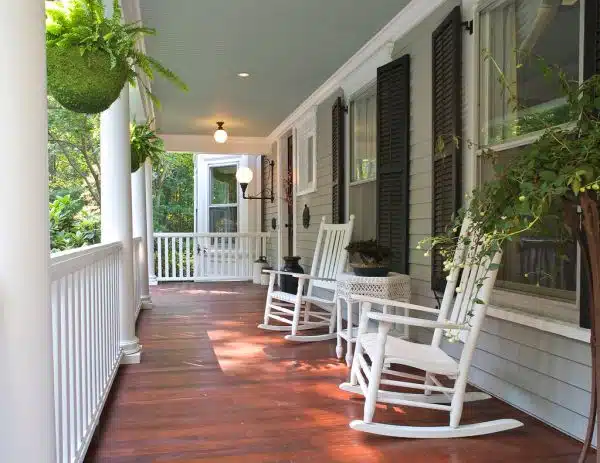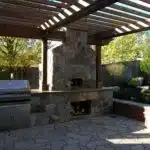Building a porch can add value and appeal to any home. Whether you want a cozy spot for morning coffee or an outdoor space for entertaining guests, a porch is the perfect solution. However, building a porch is not a simple project, and requires careful planning and execution.
Before beginning construction, it is important to consider the purpose of your porch and the design that will best suit your needs. There are several factors to take into account, including the size and shape of your property, local building codes and regulations, and materials needed for construction. In this article, we will provide step-by-step instructions on how to build a porch that will meet your specific needs while also enhancing the overall appearance of your home.
Planning Your Porch Design
When planning your porch design, the first thing to consider is how you will maximize the available space. Consider what activities you plan on doing on your porch and ensure that there is enough room for them. If you want to use it as a dining area, make sure there is ample space for a table and chairs. If you plan on using it as a lounging area, make sure there is enough room for comfortable seating.
Another consideration when planning your porch design is incorporating landscaping. This can help create a seamless transition from your yard to your porch and add visual interest. Consider adding potted plants or even creating a small garden bed around the perimeter of the porch. Not only will this enhance the overall aesthetic of your porch, but it can also provide privacy and shade.
By taking these factors into consideration when planning your porch design, you can create a functional and visually appealing outdoor living space that meets all of your needs. In the next section, we will discuss how to choose the right materials for your porch construction to ensure that it not only looks great but also stands up to wear and tear over time.
Choosing The Right Materials
When building a porch, the materials used must be chosen to ensure the best results. Wood, metal, concrete, and railings are all common choices for the various components of a porch. Flooring, roofing, posts, foundation, and fasteners must also be considered, as well as sealants, stains, paint, shutters, benches, and lighting. Each material has unique characteristics and must be chosen to match the desired aesthetic and structural requirements of the porch.
Wood
When it comes to building a porch, choosing the right materials is crucial. One of the most popular choices for porch construction is wood. However, not all types of wood are created equal. It’s important to choose the right type of wood for your porch based on its durability, resistance to weather and insects, and overall aesthetic appeal.
When selecting wood for your porch, consider using pressure-treated lumber. This type of wood has been chemically treated to resist damage from rot and insects. Another option is cedar or redwood, which are naturally resistant to decay and insects. Additionally, staining techniques can be used to enhance the longevity of your porch by protecting it from moisture damage and fading caused by UV rays.
If you’re looking for a more traditional look, consider using pine or fir for your porch construction. These types of woods are readily available and affordable, but they require regular maintenance such as staining or painting every few years. Ultimately, the type of wood you choose will depend on your specific needs and preferences in terms of durability, maintenance requirements, and overall aesthetic appeal. With careful consideration and attention to detail in selecting both the type of wood and staining techniques used on it you can build a beautiful porch that will last for years to come.
Metal
When it comes to porch construction, selecting the right materials is essential to ensure its durability and longevity. Apart from wood, metal is another popular choice for porch installation. Metal porches offer various benefits such as low maintenance, easy installation, and resistance to weather and insects.
One of the main advantages of using metal for your porch is its durability. Metal porches are resistant to rot, decay, and insect damage. They can withstand extreme temperatures, heavy rain, snowfall, and strong winds without deteriorating or warping. Additionally, metal porches require very little maintenance compared to wooden porches that need regular staining or painting.
Another benefit of using metal for your porch is its versatility in design. Metal can be easily molded into different shapes and sizes, allowing you to create a unique style that complements your home’s architecture. Moreover, metal porches come in various colors and finishes that can enhance the curb appeal of your property.
In conclusion, choosing the right material for your porch construction is vital in determining its durability and aesthetic appeal. While wood has been a traditional choice for porch installation due to its natural beauty and warmth feel, metal offers numerous benefits such as durability, low maintenance requirements, versatility in design options and resistance to weather elements making it an excellent alternative option for homeowners looking for something different but equally beautiful.
Measuring And Marking Your Property
Before beginning construction on your porch, it’s important to measure and mark your property. This ensures that you stay within the boundary line and legal requirements of your local area. Start by obtaining a copy of your property survey, which will show your property lines and any easements or zoning restrictions.
Once you have the survey, use stakes and string to mark out the perimeter of your porch. Keep in mind any slope or drainage considerations, as water should always flow away from your home’s foundation. Use a level to ensure that the ground is even and make adjustments as needed.
Before proceeding with the next step of preparing the ground for construction, make sure that all measurements are accurate and that you have followed all legal requirements for building in your area. Taking these steps now will save time and money in the long run, ensuring that your porch is safe, stable, and up to code.
Preparing The Ground
After measuring and marking your property, the next step in building a porch is to prepare the ground. Before doing anything else, it’s essential to ensure proper drainage by grading the area away from your home. This will prevent water from pooling around the foundation of your house and causing damage over time.
Another crucial aspect of preparing the ground is conducting soil testing. The quality of the soil can affect how well your porch holds up over time, so it’s important to know what you’re working with. Through soil testing, you can determine if there are any issues that need to be addressed before moving forward with construction. For example, if the soil is too soft or unstable, you may need to add additional support when building your porch.
To properly prepare the ground for a porch, follow these steps:
- Clear away any vegetation or debris from the area where you’ll be building.
- Determine the appropriate slope for drainage and grade accordingly.
- Conduct a soil test to identify any potential issues with stability or composition.
By taking these steps before digging and pouring footings, you’ll create a solid foundation for your porch that will last for years to come. Remember, proper preparation is key to ensuring a successful project that adds value and enjoyment to your home.
Digging And Pouring Footings
As the foundation of any structure, footings are essential in building a durable and sturdy porch. Digging and pouring footings is a necessary process that requires attention to detail and proper execution. Like roots supporting a tree, footings provide stability for the porch and keep it from sinking or shifting over time.
Before starting the excavation process, make sure to have all necessary tools and equipment on hand. This includes excavation equipment such as shovels, backhoes, and excavators. Once you have everything you need, begin digging the holes for the footings according to your porch’s specifications. Be sure to remove any rocks or debris from the area as they can weaken the concrete mixing.
After completing the excavation process, it’s time to pour the concrete footing. The table below outlines recommended concrete mixtures based on soil type:
| Soil Type | Cement (bags) | Sand (cubic feet) | Gravel (cubic feet) | Water (gallons) |
|---|---|---|---|---|
| Clay | 4 | 0.5 | 1 | 2 |
| Silt | 3 | 0.75 | 1 | 1.5 |
| Sand | 3 | 1 | 1 | 1 |
Mix the concrete according to these ratios in a wheelbarrow or mixer until it reaches a consistent texture. Pour this mixture into each hole until it reaches ground level then smooth out with a trowel. Allow ample time for curing before moving on to framing the porch.
To continue building your porch, framing is an essential next step that will bring your structure together. With proper planning and execution of digging and pouring footings, you’re one step closer to having a beautiful new addition to your home.
Framing The Porch
After digging and pouring the footings, it’s time to move on to framing the porch. This step is crucial in ensuring that the porch is structurally sound and able to support the weight of those who will use it. Before beginning this process, make sure to check with local building codes to ensure compliance.
When framing a porch, safety precautions should be taken seriously. Always wear appropriate safety gear such as gloves, goggles, and helmets when working with power tools or heavy materials. Additionally, make sure that all tools are in good working condition and used properly. Accidents can happen, but taking these precautions can help minimize risk.
Once the frame of the porch has been completed, it’s time for the next step: installing the decking. This is where you’ll decide on the material you want to use and begin laying it down according to your desired design. Remember to continue following building codes and safety procedures throughout this process to ensure a safe and stable final product.
Installing The Decking
As you begin to install the decking on your porch, it’s important to consider the types of decking that are available. When selecting a type of decking, there are many factors to take into account such as durability, maintenance requirements, and cost. Wood decking is a popular choice due to its natural look and feel, but it requires regular maintenance to prevent rotting or warping. Composite decking is a newer option that offers low maintenance and long-lasting durability.
Once you’ve chosen your decking material, it’s time to think about the finish. There are several options available for finishing your deck, including stains, paints, and sealers. Stains are a popular choice because they enhance the natural grain of the wood while protecting it from weather damage. Paints provide an opaque finish and can be used to create unique designs or patterns. Sealers protect the wood from moisture damage but do not add any color or design elements.
When installing your decking, be sure to follow manufacturer instructions carefully and use appropriate hardware for securing each board in place. As you work, take care to stagger the joints between boards for added stability and aesthetic appeal. Once all of your boards are securely in place, you can move on to adding railings and balusters for safety and style.
Moving forward with the installation process requires careful consideration of both decking types and finishes. It’s important to choose materials that will hold up well over time while also adding visual appeal to your porch area. Next up we’ll discuss how to add railings and balusters to complete the look of your porch while ensuring safety for all who use it.
Adding Railings And Balusters
When adding railings and balusters to a porch, consider the weight, durability, and appearance of the materials. Proper installation of the railings is key for optimum safety, strength and stability. Balusters can be installed in a variety of creative designs and patterns for a decorative touch. Make sure to follow the manufacturer’s instructions for installation and secure the balusters with fasteners.
Choosing Materials
When it comes to adding railings and balusters to your porch, choosing the right materials is crucial. Not only do they need to be strong enough to support the weight of individuals leaning on them, but they also need to withstand weather conditions and potential wear and tear. When considering cost considerations, wood is a popular choice for its affordability. However, it may not be the most environmentally friendly option as it requires cutting down trees. Alternatively, metal railings and balusters offer durability and longevity at a higher cost.
In addition to cost considerations and environmental impact, you also want to choose materials that complement the style of your porch. If you have a traditional home design, wooden railings and balusters with intricate details can add character and charm. For a modern or contemporary look, sleek metal railings may be more fitting. Additionally, if you live in an area prone to extreme weather conditions such as hurricanes or heavy snowfall, it’s important to choose materials that are resistant to damage.
Ultimately, when adding railings and balusters to your porch, selecting the right materials is critical for both aesthetic appeal and safety purposes. Take into account cost considerations and environmental impact while also ensuring that your chosen materials fit with the style of your home and can withstand harsh weather conditions. With careful consideration in selecting quality materials for your porch project, you can create a beautiful outdoor space that will last for years to come.
Installing Railings
When it comes to adding railings and balusters to your porch, choosing the right materials is just one part of the process. Equally important is installing these features properly to ensure their safety and longevity. Before choosing a railing style, it’s crucial to determine where you will be installing the railing posts. This will help you determine the necessary length and width of your railings and balusters.
Once you have determined where your railing posts will be installed, it’s time to begin installation. First, mark where each post will go using a chalk line or laser level. Then, dig holes for each post that are at least 18 inches deep. If your porch has concrete or brick flooring, you may need to use an electric drill with a masonry bit to create holes for the posts.
After digging the holes for each post, insert them into place using concrete mix or gravel as needed for stability. Make sure each post is level and straight before allowing the concrete or gravel to dry completely. Once all posts are secure, attach your chosen railings and balusters according to manufacturer instructions. With proper installation techniques, your new porch railings and balusters can provide both aesthetic appeal and safety benefits for years to come.
Installing Stairs
After successfully adding railings and balusters to your porch, it’s time to move on to the next step: installing stairs. Staircase design is crucial in ensuring the safety of those who will be using it. Whether you’re building a set of straight stairs or a more complicated design, consider factors such as the height of each riser, the width of each tread, and the angle of inclination.
In terms of safety considerations, it’s important to make sure that your stairs meet local building codes and regulations. This includes adherence to minimum and maximum rise and run measurements, as well as requirements for handrails and guardrails. Non-slip treads can also be added for additional safety measures. It’s essential to prioritize functionality over aesthetics when it comes to staircase design.
Once your stairs are installed and meet all necessary safety standards, you can move on to adding finishing touches. This could include painting or staining the wood, installing decorative brackets or finials, or even adding lighting for visibility at night. Remember that while these finishing touches can add a nice touch aesthetically, they should never compromise the safety or functionality of your porch stairs. With careful attention paid to both design and safety considerations, you’ll have a beautiful and functional set of porch stairs in no time.
Adding Finishing Touches
Like a blank canvas, a newly built porch is just waiting for those finishing touches that will make it truly special. One of the most important decisions to make when adding these touches is choosing colors that complement the rest of your home’s exterior. Consider the colors of your siding, roof, and trim when choosing paint or stain for your porch flooring and railings. You’ll want to create a cohesive look that ties everything together.
Once you’ve chosen your colors, it’s time to accessorize your porch furniture. Adding cozy cushions, throw pillows, and even an outdoor rug can create a welcoming atmosphere that invites guests to sit down and stay awhile. Keep in mind that these accessories will be exposed to the elements, so choose materials that are durable and easy to clean.
By adding these finishing touches to your porch, you can transform it into an inviting space where you can relax with family or entertain guests. But before you can enjoy all the beauty of your new porch, there’s one final step: painting or staining the porch. This process will help protect your investment from the elements while also adding color and personality to your outdoor space. In the next section, we’ll guide you through this crucial step in building your dream porch.
Painting Or Staining The Porch
Painting or staining a porch can be a great way to improve its appearance and protect it from the elements. Both options have their own advantages, depending on your preferences and needs. Painting provides more color options and can be easier to maintain, while staining allows the natural beauty of wood to shine through.
If you decide to paint your porch, you will have a wide range of colors to choose from. You can match the color of your home’s exterior or choose a contrasting color that adds visual interest. Paint also creates a smooth, even surface that is easy to clean with soap and water. However, paint may peel or chip over time, especially in areas with heavy foot traffic.
Staining is another popular option for porches made of wood. It enhances the natural grain and texture of the wood while protecting it from moisture and UV damage. Stain also penetrates deeper into the wood than paint, providing longer-lasting protection against wear and tear. However, stain colors are limited compared to paint, and it may require more maintenance over time.
When considering painting or staining your porch, it’s important to weigh the pros and cons of each option based on your specific needs and preferences. Whether you choose paint or stain, both options can add value and curb appeal to your home’s exterior. In the next section, we will discuss how installing lighting can further enhance your porch’s appearance at night.
Installing Lighting
- When installing lighting on a porch, it is important to consider the many types of lighting available, as each type has its own advantages and disadvantages.
- Electrical wiring and connections must be made properly to ensure safety.
- Before beginning a porch lighting project, homeowners should be familiar with their local building codes and electrical regulations.
- Outdoor lighting fixtures must be rated for outdoor use and be compatible with the electrical system in the home.
- It is important to take special care when running electrical wiring through walls or other concealed spaces.
- Homeowners should consult a professional electrician if they are unsure of any steps when installing lighting on a porch.
Types Of Lighting
When it comes to building a porch, one important aspect that should not be overlooked is the type of lighting to install. Outdoor fixtures come in various designs, each with its unique features and benefits. It’s essential to choose the right type of lighting that fits your needs and preferences.
Energy efficiency is an essential factor to consider when selecting outdoor fixtures. LED lights are an excellent energy-efficient option as they consume less energy than traditional incandescent bulbs. They also last longer, making them a cost-effective solution for porch lighting. Solar-powered lights are another eco-friendly option that harnesses solar energy during the day and illuminates your porch at night.
The placement of your outdoor fixtures also plays a crucial role in achieving optimal lighting for your porch. Consider installing wall sconces on either side of the front door or hanging pendant lights from the ceiling for a warm glow. Pathway lights can provide visibility and safety while highlighting your landscaping features. With careful consideration of these factors, you can achieve a well-lit porch that enhances the overall aesthetic appeal of your home.
Wiring And Connections
As we continue our discussion on installing lighting for your porch, we cannot overlook the importance of wiring and connections. The wiring and connections play a crucial role in ensuring that your outdoor fixtures function optimally and safely. A smart home installation is an excellent option if you want to control your outdoor lighting remotely. This technology allows you to control your porch lights from anywhere, using your smartphone or tablet.
When it comes to wiring and connections, it’s essential to prioritize safety. It’s best to hire a professional electrician who can ensure that the wiring is done correctly and meets all safety standards. Outdoor lighting requires different wiring from indoor lighting due to exposure to weather elements such as rain, wind, and snow. Moreover, proper grounding is essential to prevent electrical shock or damage.
Lastly, when it comes to installing outdoor lighting, it’s essential to consider the types of connections needed for each fixture. Some fixtures require direct connection while others use a plug-in connection. Additionally, some fixtures come with automatic timers or motion sensors that require specific connections. Therefore, it’s vital to read the manufacturer’s instructions carefully before installation.
Safety Precautions
As we have discussed earlier, installing lighting for your porch requires proper wiring and connections. In this section, we will focus on the safety precautions that need to be taken during the installation process. Safety should always be a top priority when working with electricity, and appropriate safety gear should be worn at all times. This includes gloves, eye protection, and non-conductive footwear.
Before starting any installation work, it’s essential to carry out an inspection checklist. The checklist should cover all aspects of the installation process, including the condition of the wiring and connections in use. The electrical system must also be checked for overloading or any potential hazards such as exposed wires or inadequate grounding. Any issues found during the inspection should be resolved immediately before proceeding with the installation.
In conclusion, ensuring adequate safety precautions are taken when installing porch lighting is crucial. It is vital to wear appropriate safety gear and perform a thorough inspection before beginning any work. Taking these necessary steps can help prevent accidents or injuries from occurring and ensure that your outdoor lighting system functions optimally for years to come.
Adding Furniture And Decorations
Did you know that adding furniture and decorations to your porch can increase the overall value of your home? A study conducted by the National Association of Realtors found that outdoor living spaces, including porches, play a significant role in attracting potential buyers. So not only does adding furniture and decorations create an inviting space for you to enjoy, but it can also be a smart investment.
Choosing colors for your porch furniture and decor can be a fun task, but it’s important to keep in mind the overall aesthetic of your home. If your home has a neutral color palette, consider adding pops of color with bright accessories such as throw pillows or a vibrant rug. On the other hand, if your home has bold colors, opt for more muted tones to create balance. Remember to also consider the climate in your area when choosing materials for outdoor furniture.
Coordinating accessories is another key component when decorating your porch. Don’t be afraid to mix and match patterns and textures, but make sure they complement each other. Incorporate elements such as plants, lighting fixtures, and artwork to add depth and personality to your space. And don’t forget about functionality – choose furniture pieces that serve a purpose such as storage benches or side tables.
As you begin enjoying your newly decorated porch, it’s important to keep up with maintenance tasks. From cleaning cushions to power washing floors, regular upkeep will ensure that your investment lasts for years to come. In the next section, we will discuss tips on maintaining your porch so that you can continue enjoying it for many seasons ahead.
Maintaining Your Porch
Regular maintenance is essential to keep your porch in tip-top shape. To maintain your porch, start by cleaning it regularly with a broom or a vacuum. This helps remove dust, debris, and dirt that can cause damage over time. You should also wash the porch floor and walls at least once a year using a mild detergent and warm water. After washing, rinse the porch with clean water to remove any remaining soap residue.
Weather protection is another crucial aspect of maintaining your porch. Your porch is constantly exposed to different weather conditions like rain, snow, and sunlight, which can cause significant damage if not properly protected. One way to protect your porch from weather damage is by applying a sealant or waterproofing agent to the wood or concrete surfaces. This will help prevent water from seeping into the porch’s structure and causing rot, mold growth, or other types of damage.
Regular maintenance and weather protection are key to keeping your porch beautiful and functional for years to come. Here are four simple tips that you can follow:
- Inspect your porch for signs of damage such as cracks or loose boards regularly.
- Keep plants away from the edges of your porch to prevent root growth that may cause structural damage.
- Trim trees near your porch so that branches don’t scrape against it during high winds.
- Avoid using harsh chemicals when washing your porch as they might strip away any protective coating.
Now that you know how important regular maintenance and weather protection are for your porch’s longevity let’s move on to some common mistakes people make when building their porches that you should avoid if you want yours to last longer!
Common Mistakes To Avoid
Mistakes to Avoid When Building a Porch
Building a porch is an exciting project that can add value and curb appeal to your home. However, it’s important to avoid common mistakes in the design and budgeting process to ensure a successful build. One of the most significant mistakes people make when designing their porch is failing to consider the style and architecture of their home. A porch that clashes with the rest of your house can detract from its aesthetic appeal and ultimately decrease its value.
Another mistake people make is underestimating the costs associated with building a porch. It’s essential to create a realistic budget that takes into account all necessary materials, labor costs, and permits required for construction. Failing to do so can lead to unexpected expenses down the line, which can put you over budget and delay your project’s completion.
Lastly, overlooking safety considerations when designing your porch can also be a costly mistake. Ensuring that your porch is built with proper structural support, sturdy railings, and slip-resistant surfaces is crucial for preventing accidents. Neglecting these elements can result in costly repairs or even legal issues if someone is injured on your property.
In conclusion, avoiding these common mistakes in design and budgeting will help ensure that your porch building project is successful both aesthetically and financially. By carefully considering these factors before beginning construction, you’ll save time, money, and hassle down the line while enjoying a beautiful new addition to your home.
Conclusion
Building a porch can be a great way to enhance the curb appeal of your home and create an inviting outdoor space for relaxing or entertaining. By following the steps outlined in this article, you can plan and execute a successful porch build that will add value to your property.
First, it is important to carefully consider your porch design and choose materials that are both durable and aesthetically pleasing. Once you have measured and marked your property, you can begin preparing the ground and pouring footings. Installing lighting and adding furniture and decorations will help to create a cozy atmosphere on your new porch.
To maintain your porch, regularly clean it with a mild detergent and inspect it for any signs of wear or damage. Common mistakes to avoid include using insufficient support structures for the roof and failing to properly seal all joints and connections.
For example, let’s say that John wanted to build a porch onto his home. He spent time carefully planning his design, choosing materials that would complement his house’s exterior, and measuring his property accurately. With guidance from this article, John successfully poured footings, installed lighting fixtures, added comfortable seating arrangements, and decorated the space with potted plants. Now John can enjoy his new porch for years to come thanks to following these helpful steps.
Image Credits
- “Porch” by sonjalovas (featured)









![How To Build A Detached Deck 9 Force Reconnaissance Detachment Deck Shoot [Image 4 of 4]](https://green-life.blog/wp-content/uploads/2023/05/RJo3tlizSGjq-150x150.jpg.webp)





![How To Repair Rotted Wood 15 Texture : Altario Buick Estate Wagon : Rotting Faux Wood Paneling [1 of 2]](https://green-life.blog/wp-content/uploads/2023/05/z1CersK-gCjq-150x150.jpg.webp)













